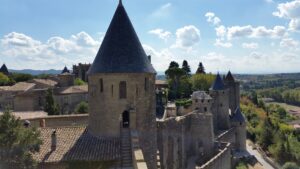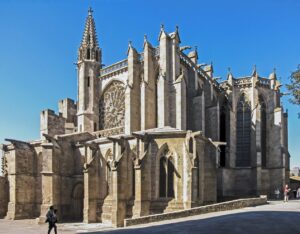The Middle Ages always had an attraction for us when we were kids. Knights, damsels in distress, jousts and big feasts in castles halls just seemed so wondrous. Robin Hood, El Cid, and Joan of Arc were our heroes and the Sherriff of Nottingham was the evil villain. Later in life, Henry V at the Battle of Agincourt (both the Laurence Olivier and Kenneth Branaugh versions) thrilled us yet again. If you were anything like us, you ought to take a trip to Carcassonne when you’re wine tasting in southwest France.
Carcassonne viewed from afar. Photo courtesy of European Waterways.
As you drive up to the town, you’ll see this magnificent walled city on a hilltop. There is a modern-day town surrounding the castle, but it’s of no particular interest. It’s the imagery of battles and courtly love that will rush back into your mind as soon as you see Carcassonne. And it’s real.
Well, almost real. There was a walled town there in the Middle Ages and it did figure in some significant battles, particularly in the Albigensian Crusade, that pitted the Papacy versus the Cathars. (The Pope won.) But by the early 1800’s, the town and its castle had fallen into disrepair and was going to be torn down.
Then along came Eugène Viollet-le-Duc. He was a French architect, a visionary and someone who must have had the same childhood fantasies we did. He set about restoring great medieval buildings, not least of which was the Cathedral of Notre Dame in Paris. When he turned his attention to Carcassonne, he took what was still a military stronghold and turned it into a Middle Ages wonderland.
The lovingly restored Basilique de St-Nazaire. Photo courtesy of Wikipedia.
For today’s visitor, there’s no reason to concern yourself that Viollet-le-Duc wasn’t exactly archeologically correct in restoring Carcassonne. If what we see today isn’t exactly as it was, it is what it should have been. Soaring walls, towers with arrow slits for the archers, tessellated ramparts, inns (well, they’re really restaurants) where you can quaff your ale (or enjoy a glass of wine). They’re all there in Carcassonne.
Entry to the old town is free, but parking isn’t. And if you get there at any reasonable hour, you’ll find the nearest empty lots are quite a walk away. Of course, that gives you the chance to approach the great walls and turrets slowly and take them in at leisure. Once inside, you’ll find a whole town’s worth of genuine medieval buildings, buffed up and gleaming. Unfortunately, you’ll also find the usual run of shops selling knickknacks, tee shirts and junk. But you’ll also encounter bookstores with a considerable collection of material on the Middle Ages and the events that have occurred around Carcassonne. Many are in French, but enough are translated to keep you interested.

You can walk the walls of Carcassonne.
We recommend that you pay the fee to tour the walls around the city. It’s not too hard to imagine hordes of English troops approaching from afar and the sturdy Carcassonais defending their fortifications. By the way, those enemy troops might also have been French, because Carcassonne was part of Spain in medieval times. You should also see the Basilique de St- Nazaire, begun in the 11th Century. It’s fine gothic architecture, suitably embellished by Viollet-le-Duc.
If you ever dreamed over Prince Valiant on a Sunday morning, you’ll love Carcassonne.

